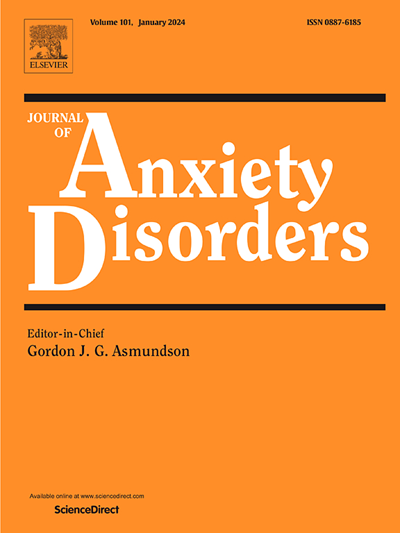惊恐障碍、社交焦虑障碍和健康对照对迫在眉睫威胁的脑-心耦合反应
IF 4.5
2区 医学
Q1 PSYCHIATRY
引用次数: 0
摘要
迫在眉睫的威胁不仅会吸引注意力,还会引发与战斗-逃跑-冻结行为相关的防御性心理生理反应。然而,注意刺激处理的中心标记与早期防御激活的外围成分(如心脏加速)之间的主体内关联尚未得到很好的理解。这些关联对于理解以恐慌症等心血管症状为特征的焦虑障碍的动力学尤为重要。方法对惊恐障碍(PD)、社交焦虑障碍(SAD)和健康对照组(CG)的90名参与者(N = )进行数据分析,这些参与者完成了以面部刺激为条件刺激(CS)和以厌恶白噪声爆发为非条件刺激(US)的威胁条件反射范式。除了erp和心跳的单变量分析外,我们还使用中央中心位置和心脏周期的噪声爆发引起的单试验脑电图来计算非条件皮质-心脏反应的个体内耦合。结果噪声诱发了强烈的心脏加速和具有明显N100成分的事件相关电位。重要的是,单次试验心脏加速的幅度是通过之前的单次试验N100幅度来预测的。与社交焦虑障碍患者相比,惊恐障碍患者的这种皮质-心脏耦合(而非N100成分或心脏加速本身)增强,在健康对照中观察到中等水平的耦合。结论早期注意刺激加工在随后的心脏防御反应中起核心作用。此外,他们指出,皮质-心脏防御反应可能在惊恐障碍患者中发生改变,而不是在一般的焦虑症中发生改变。本文章由计算机程序翻译,如有差异,请以英文原文为准。
Brain-heart coupling in response to imminent threat in panic disorder, social anxiety disorder, and healthy controls
Background
Imminent threat does not only capture attention but also triggers defensive psychophysiological responses associated with fight-flight-freeze behavior. However, within-subject associations between central markers of attentional stimulus processing and peripheral components of early defensive activation (e.g., cardiac acceleration) are not well understood. These associations may be especially important in understanding dynamics of anxiety disorders that are characterized by cardiovascular symptoms such as panic disorder.
Methods
We analyzed data from N = 90 participants with panic disorder (PD), social anxiety disorder (SAD), as well as healthy controls (CG) who completed a threat conditioning paradigm with face stimuli as conditioned stimuli (CS) and an aversive white noise burst as unconditioned stimulus (US). In addition to univariate analyses of ERPs and heartbeat, single-trial EEG evoked by the noise burst at centromedial sites and heart period were used to calculate intraindividual coupling of unconditioned cortico-cardiac responses.
Results
The noise burst evoked strong cardiac acceleration and an event-related potential with a pronounced N100 component. Importantly, the magnitude of single-trial cardiac acceleration was predicted within individuals by the preceding single-trial N100 magnitude. This cortico-cardiac coupling, but not the N100 component or cardiac acceleration per se, was enhanced in individuals with panic disorder compared to social anxiety disorder, with intermediate levels of coupling observed in healthy controls.
Conclusion
The present results suggest a central role of early attentional stimulus processing in subsequent cardiac defensive responses. Furthermore, they indicate that cortico-cardiac defensive responses may be altered in individuals with panic disorder specifically, rather than in anxiety disorders in general.
求助全文
通过发布文献求助,成功后即可免费获取论文全文。
去求助
来源期刊

Journal of Anxiety Disorders
Multiple-
CiteScore
16.60
自引率
2.90%
发文量
95
期刊介绍:
The Journal of Anxiety Disorders is an interdisciplinary journal that publishes research papers on all aspects of anxiety disorders for individuals of all age groups, including children, adolescents, adults, and the elderly. Manuscripts that focus on disorders previously classified as anxiety disorders such as obsessive-compulsive disorder and posttraumatic stress disorder, as well as the new category of illness anxiety disorder, are also within the scope of the journal. The research areas of focus include traditional, behavioral, cognitive, and biological assessment; diagnosis and classification; psychosocial and psychopharmacological treatment; genetics; epidemiology; and prevention. The journal welcomes theoretical and review articles that significantly contribute to current knowledge in the field. It is abstracted and indexed in various databases such as Elsevier, BIOBASE, PubMed/Medline, PsycINFO, BIOSIS Citation Index, BRS Data, Current Contents - Social & Behavioral Sciences, Pascal Francis, Scopus, and Google Scholar.
 求助内容:
求助内容: 应助结果提醒方式:
应助结果提醒方式:


